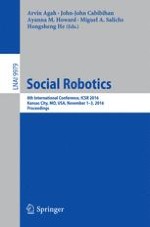2016 | OriginalPaper | Buchkapitel
Enabling Symbiotic Autonomy in Short-Term Interactions: A User Study
verfasst von : Francesco Riccio, Andrea Vanzo, Valeria Mirabella, Tiziana Catarci, Daniele Nardi
Erschienen in: Social Robotics
Aktivieren Sie unsere intelligente Suche, um passende Fachinhalte oder Patente zu finden.
Wählen Sie Textabschnitte aus um mit Künstlicher Intelligenz passenden Patente zu finden. powered by
Markieren Sie Textabschnitte, um KI-gestützt weitere passende Inhalte zu finden. powered by
